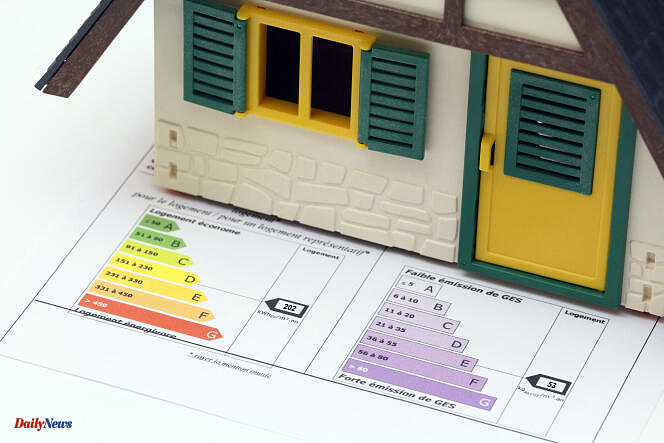The government put a public consultation online on Tuesday, February 20, concerning the change in the calculation of the energy performance diagnosis (EPD) for small areas. A few days ago, in Le Parisien, the Minister of Ecological Transition, Christophe Béchu, expressed his desire to remove 140,000 housing units from the energy sieve category (labeled F or G), estimating that “the DPE thresholds were biased against small areas”. According to the minister, “more than 27% of very small goods”, less than 40 square meters, currently fall into the category of thermal strainers.
But the draft decree, which should come into force this summer, raises doubts among federations of tenant representatives and owners.
Since 2006, the DPE has made it possible to classify homes according to their energy consumption, from A (extremely efficient) to G (thermal strainer). These labels initially only had an informative value. Everything changes in 2021 with the climate and resilience law: the DPE becomes “enforceable” and therefore takes on legal value. In the event of an error in the diagnosis, the buyer or tenant can take action against the diagnostician and against the seller or lessor of the accommodation, who can also demand accountability from the diagnostician.
Since 2023, the DPE has been a central tool in the energy renovation policy, which meets a dual objective: fighting global warming and reducing energy poverty. In France, the building sector generates 23% of greenhouse gas emissions and represents 43% of the country's energy consumption.
A progressive timetable plans to prohibit the rental of the most energy-intensive accommodation. These prohibitions will only apply at the end of the leases, tenants will not be pushed out, but upon their departure the accommodation cannot be rented out without energy renovation work.
Rents for housing labeled F or G can no longer be increased since August 2022.
According to estimates from the Ministry of Ecological Transition as of January 1, 2023, out of the 30 million main residences, the number of energy sieves (F and G) was estimated at nearly 4.8 million housing units, or 15.7% of housing, and even 21.7% in Ile-de-France. Without renovation, almost one in two homes could no longer be rented by 2034 in Ile-de-France (47.5% with E to G label compared to 35.3% throughout the country).
This timetable, coupled with the current state of the housing stock, raises fears of a runaway housing crisis. The National Real Estate Federation (Fnaim) has been warning since 2022 of a “risk of hemorrhaging of the private rental stock”, while other players in energy renovation are calling for more incentives for landlords.
Since 2021, diagnosticians have carried out DPEs using a unique method, the calculation of conventional housing consumption, or 3CL, which is based on two criteria:
At the end of the diagnosis, valid for a period of ten years, a letter going from A to G is assigned to the accommodation and determines its energy performance.
However, doubts remain about the reliability of this 3CL method which replaced the previous one, based on energy bills from the previous three years. According to a UFC-Que Choisir survey from 2022, there can be “up to three classes of difference for the same property”, depending on the diagnostician employed.
For Jean-Christophe Protais, the president of Sidiane, an interprofessional union for real estate diagnostics, “the reliability of a DPE is linked to two things: to the housing data made available to the diagnostician, such as the year of construction of the well and the dates of the insulation work, and the training of these professionals”. A July 2023 decree should improve apprenticeship in the profession and standardize practices.
The president of the National Housing Confederation (CNL), Eddie Jacquemart, regrets that real estate diagnosticians are chosen by the owners themselves to carry out DPEs. “The profession is not regulated enough,” he believes. The allocation of diagnosticians to owners should be random. »
Christophe Béchu wishes to correct “a calculation bias” in the DPE. According to a study by the National Energy Renovation Observatory published in 2022, “nearly 34% of homes of less than 30 square meters have an F or G label, compared to only 13% of homes of more than 100 square meters. » Proportionally, small homes would, according to this report, consume more heating than larger ones since they have more heat-losing walls (walls, floors or roofs) in relation to their living space. Hot water consumption, relative to the number of square meters of housing, is also higher in a small, more densely occupied property.
The 3CL method will not be changed. Only the weighting coefficients and the thermal compactness index of housing less than 40 square meters will be modified after the entry into force of the decree, scheduled for July 1, 2024.
Currently, a property is classified as Category G if its energy consumption exceeds 420 kilowatt hours per square meter per year and its greenhouse gas emissions exceed 100 kilograms of CO2 equivalent per square meter per year. With the reform, small areas will be authorized to exceed these requirements since these thresholds will be revised upwards.
Owners who have recently carried out a DPE will be able to request a re-evaluation of the label of their home, without repeating the diagnosis, by applying the weighting coefficients for small areas and perhaps obtain a better score.
According to the Ministry of Ecological Transition, nearly 140,000 homes will be assigned a new label from July 1 and will be able to move out of categories F and G, that of thermal strainers.
Even if he suspects the ministry of inflating its estimate, Loïc Cantin, the president of Fnaim, who has long called for more egalitarian adjustments "between small and large stores", happily welcomes the new measure. “The approach of January 1, 2025 – and the ban on the rental of G-rated housing – is a source of concern for the market,” insists Mr. Cantin. We feel that there are adjustments on the part of the government, a little more consideration and taking into account the consequences that a poor classification of DPE can have on the market. »
Isabelle Gasquet, “energy efficiency” project manager for the CLER-Réseau association for the energy transition, regrets, however, the government's silence on the 3.4 million households in a situation of energy poverty: “It is not because that a home will suddenly go from G to E, without work, that it will become better for the tenant: their energy bill will remain high and it will once again be possible to increase their rent. »
At a time when Bercy announced the reduction in the budget for energy renovation aid MaPrimeRénov', from 5 to 4 billion euros for 2024 due to poor growth forecasts, these "unraveling measures" on the DPE sound like a failure on an ecological level, both for the CNL and for the CLER. “We must continue to encourage landlords to undertake energy renovation,” insists Ms. Gasquet. If the government sends a signal that it is making corrections here and there as the timetable intensifies, these owners risk adopting a wait-and-see attitude in the hope that the criteria will evolve further. » And remember that “the vast majority of owners are multiple owners and have the means to carry out this work”. According to a study by the National Institute of Statistics and Economic Studies published in 2021, there are very few owners of at least five homes (3.5% of households), but they hold 50% of rental homes. by individuals.












